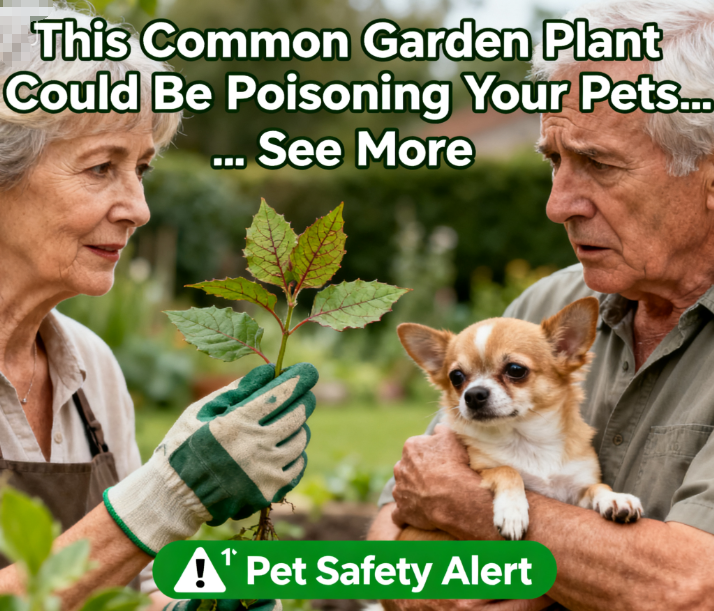
This Common Garden Plant Could Be Poisoning Your Pets… See More
It starts innocently enough. You’re puttering in your garden on a sunny afternoon, tending to the vibrant blooms and lush greenery that bring you so much joy. Your dog lies nearby, chewing on a stick, while your cat naps in a patch of sun. It’s a peaceful scene—until you notice your dog has become curiously interested in that beautiful lily plant near the fence. You might even smile, thinking how nice it is that they’re enjoying the garden with you. What you don’t know is that within hours, that same plant could send your beloved pet into kidney failure.
Many of the plants we cultivate for their beauty or convenience hide dangerous secrets, particularly for our four-legged family members. As we age, our gardens often become our sanctuaries—places of beauty, therapy, and connection with nature. We select plants for their color, their hardiness, their ability to attract butterflies. Rarely do we consider which ones might be silently threatening the animals who share our homes and yards.
The lily family stands as one of the most dangerous offenders, especially for cats. Easter lilies, tiger lilies, daylilies, and Asiatic lilies contain toxins that can cause acute kidney failure in felines. Even minimal exposure—a few bites of a leaf, a sip of water from the vase holding cut flowers, or pollen groomed from fur—can have devastating consequences. Symptoms often begin subtly: lethargy, loss of appetite, vomiting. Within days, without immediate veterinary intervention, the damage can become irreversible.
But lilies aren’t the only threat. Sago palms, those attractive tropical-looking plants popular in warmer climates, contain cycasin, a toxin that attacks the liver. Dogs find the seeds particularly appealing, and ingestion can lead to vomiting, diarrhea, seizures, and even death. Azaleas and rhododendrons, staples in many landscapes, contain grayanotoxins that can disrupt sodium channels affecting the skeletal and cardiac muscle, leading to weakness, drooling, and cardiovascular collapse.
The autumn crocus, often confused with the spring-blooming crocus, contains colchicine, a compound that causes severe gastrointestinal distress, kidney and liver damage, and respiratory failure. Oleander, with its beautiful flowers and tough disposition, contains cardiac glycosides that can cause fatal heart abnormalities if ingested. Even the common tomato plant’s green parts and unripe fruits contain solanine, dangerous to both dogs and cats.
What makes this particularly concerning for older adults is that our pets often become our constant companions in retirement. They provide comfort, routine, and unconditional love. Yet many of us remain unaware that the very garden we’ve cultivated for pleasure might harbor hidden dangers. The situation becomes even more risky when pets age alongside us—their senses may dull, making them more likely to chew on inappropriate items, and their bodies become less resilient to toxins.
The signs of plant poisoning can be subtle and easily mistaken for normal aging changes. When your sixteen-year-old cat vomits, you might attribute it to hairballs or senior sensitivity. When your dog seems lethargic, you might assume they’re just having an off day. This is why awareness matters—recognizing the early signs and knowing which plants pose risks could literally save your pet’s life.
Prevention begins with identification. Walk through your garden with your veterinarian’s list of toxic plants or use a reliable app to identify potentially dangerous species. Consider creating raised beds or decorative fences around hazardous plants. When choosing new plants, prioritize pet-safe options like marigolds, roses, snapdragons, and sunflowers.
Indoor plants require equal attention. Many popular houseplants—including peace lilies, pothos, and philodendron—contain calcium oxalate crystals that cause oral irritation and swelling. Bulb plants like amaryllis and daffodils can cause serious gastrointestinal upset. Even the seemingly innocent aloe vera plant, prized for its healing properties, contains saponins that can cause vomiting and diarrhea in pets.
Education is your first line of defense. Keep the ASPCA’s Animal Poison Control Center number posted prominently. Know the location and hours of your nearest emergency veterinary clinic. Watch for symptoms including vomiting, diarrhea, drooling, difficulty breathing, lethargy, and unusual behavior.
Our pets trust us completely. They rely on us to keep them safe in the environments we create. As we nurture our gardens, let’s also nurture their well-being by ensuring our botanical choices don’t threaten their health. The beauty of a flower isn’t worth the life of a faithful companion.